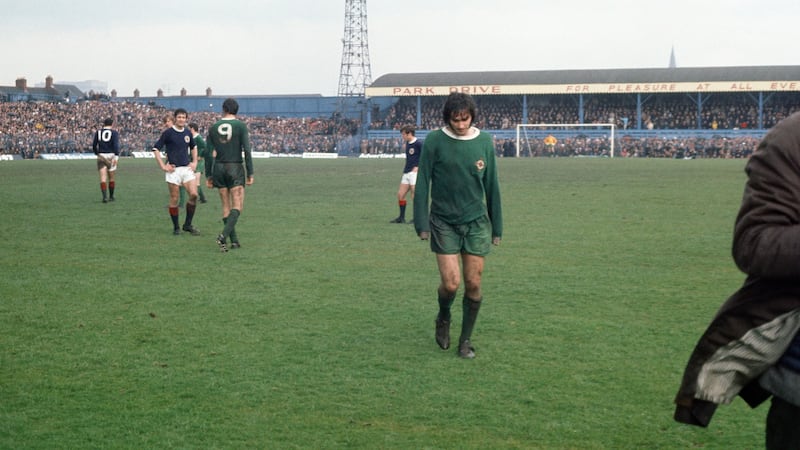For a few years after the turn of the century, Goran Ivanisevic and Lleyton Hewitt had their glory days in Wimbledon’s Centre Court.
Then Roger Federer burst on to the scene, and the Fed express would take hold of the championships in 2003 and not let go for five straight years.
They were the days of Venus and Serena Williams, athleticism with sass and attitude. Combined, the sisters sacked the trophy room and brought some rock’n’roll to the All-England Club.
In those years I stayed at a hotel in South Kensington for the Wimbledon fortnight and twice each day walked up and down Cromwell Road to get to the Gloucester Road train station.
Ciarán Murphy: GAA should not be cowards and must cut ties with Allianz over Gaza
Brazilian influence steadying Shakhtar as they face Shamrock Rovers amid the strains of war
Gordon D’Arcy: Ireland’s loss against South Africa highlighted one of our biggest problems
When is the World Cup draw and who could Ireland meet if they win playoffs?
From there it was a straight seven-stop run on the District Line to Southfields, for the walk up Church Road.
On the commute, I used to peer in through the windows of the private Cromwell Hospital, because UK newspapers reported that George Best was being treated there.
[ George Best: A footballer for all seasonsOpens in new window ]
He attended the hospital in 2001 and received his first liver transplant in 2002. Prof Roger Williams, the liver specialist who had supervised the treatment, indicated to the Guardian at the time that he had not charged the former Manchester United player, a tacit acknowledgment that he couldn’t afford it.
In hindsight, looking into a hospital seemed like an intrusive, overly curious thing to do. But I couldn’t help a discreet peek twice a day, hoping against all odds that I’d catch a glimpse of the greying raven hair or put an eye on the unmistakable shape, the movement of George Best. I figured I’d know it when I saw it.
I saw nothing but bespectacled figures peering back.
A backup Wimbledon fortnight plan, which was never realised, involved going to his favourite London pub, the Phene Arms in Chelsea, where he was its most celebrated client.
That strategy was simple. Get out of the tennis early and go sit and wait in the pub, again in the hope of seeing him drop in, and watch him sit there with his crossword, sipping glasses of wine.
But after consideration, the idea seemed weird and creepy. A faithful disciple of George Best becoming just another surreptitious gawker, a thief of his moments of relative privacy?

I dismissed thoughts of embedding in the Phene Arms as tawdry and disrespectful.
But deep down, the real reason was I bottled it, afraid to see him overweight or ageing faster than he should.
At the heart of it was the feeling that “El Beatle”, as the Portuguese press named him, should remain how he once was.
Memory was the thing. George Best, his talent and magnetism, which was not fully understood by me as a child, had remained set in time as I aged.
His image, remembered through the prism of Shoot magazine’s glossy photographs and Q&As of George’s favourite animal and George’s favourite colour, had not grown old.
At his peak for Manchester United in the Summer of Love in 1967 he could have been whipped from a protest sit-in on San Francisco’s Haight Street or from a Grateful Dead peace concert on the Panhandle in Golden Gate Park.
He bestrode pop culture, his tie-dyed shirts and cravats barely containing his professionally trained, Marbella-bronzed body as he was photographed slung over the bonnets of sports cars or pouring bubbly into stacked champagne glasses.
He blurred the lines. George Best was as much Top of the Pops studio as Old Trafford stadium.
But by the 1970s he had become like the city he came from, Belfast – troubled, and dangerously breaking down.
The one time I did see him was when Northern Ireland played against Scotland in 1970. Black hair unkempt and his jersey of shimmering green, he was a scarecrow ghosting above the turf of Windsor Park.

Mercurial and luminescent, he charged a dull April afternoon. Then he threw mud at the referee and was sent off.
By then he had become as much of a sociological study as a footballer. He boarded a flight to the Costa del Sol when the rest of the team trained at The Cliff. Management at the club had long lost patience.
But not the tabloids. Not me.
By the end his boldness reached deep into self-destruction as he took his new liver on a white-knuckle ride around the chicanes and contours of wine spritzers and pub life.
During Covid former Manchester United player and podcaster Eamon Dunphy told an anecdote about going over to meet George and his agent about writing a book. They went to a hotel to have a few drinks and soon after George got up to go to the loo.
Half an hour later, no sign. “That’s it,” said the agent, snapping to her feet. “He’s not coming back.” Without saying a word, he had left for a London casino.
There was more than one addiction he battled.
George Best died in the Cromwell Hospital of multiple organ failure brought on by alcoholism on November 25th, 20 years ago. His anniversary was on Tuesday.
Federer and Serena Williams have long retired (although Venus Williams says she’s still not done playing). Goran Ivanisevic is 54 years old. But when in London around the Royal Albert Hall and Hyde Park or the Michelin building restaurant in Chelsea, or on the walk to Cromwell Road, the throwaway talent of the fifth Beatle fills the air.
















